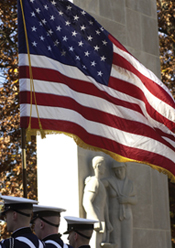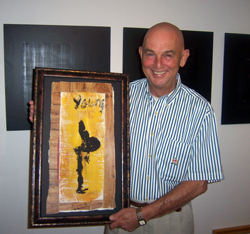 The Ut Prosim Society | Making an impact for two decades The Ut Prosim Society | Making an impact for two decades
by Amy Boyce
|
|

 The 20th annual gathering of the Ut Prosim Society The 20th annual gathering of the Ut Prosim Society
|
|
|
|
|
|
Created to recognize donors who are philanthropic leaders, the Ut Prosim Society epitomizes the university's motto, Ut Prosim (That I May Serve). Since the society's inception in July of 1986, 1,734 distinguished men and women have been named members. These individuals have contributed more than $445 million to the university in the past 20 years, accounting for an astonishing 40 percent of the total giving to Virginia Tech during that time.
|
More than 600 members of the society celebrated its 20th annual gathering on April 28 and 29 by mingling with friends, celebrating their accomplishments, and recognizing the 72 new and advancing members of the society.
Friday night began with a reception at The Inn at Virginia Tech. The Latham Ballroom was transformed into a tropical paradise, with food stations offering cuisine from the Serengeti, the Amazon, Sumatra, and other parts of the world.
On Saturday, each college hosted an open house and offered tours and presentations about its students, faculty, and research. Donors had the chance to meet some of Virginia Tech’s finest student athletes at the Athletic Director's Honors Breakfast, and President's Circle members lunched with students from the Virginia Tech University Honors Program. There was also a chance to play golf at the new Pete Dye River Course of Virginia Tech and to attend a matinee performance of "Romeo and Juliet."
The weekend was capped off by a black-tie reception and dinner on Saturday night, when members celebrated the many accomplishments of the society and Virginia Tech over the past two decades. The program made it clear that the spirit of Ut Prosim is still alive and well at the university.
Closing the evening, honors student Gregory Sagstetter -- a junior who is double-majoring in philosophy and political science and who is a member of USA Today's All-USA Academic Second Team, the treasurer of the Philosophy Club, and a volunteer firefighter -- told attendees how the Honors Program has helped make his accomplishments possible and how the university community of students, faculty, and friends has taught him the true meaning of Virginia Tech's motto.
Saturday night also saw the induction of eight new members into the President's Circle. The new members are Mr. and Mrs. Eugene V. Fife, Mr. and Mrs. Norris E. Mitchell, Mr. and Mrs. Michael J. Quillen, June O. Shott, and W. S. (Pete) White.
 Amy Boyce is publications editor for the Office of University Development. Amy Boyce is publications editor for the Office of University Development.
|
|
|
|
|
The Ut Prosim Society was created to recognize donors who are leaders within the community of philanthropy that sustains Virginia Tech. By giving so generously of their time, talent, and treasure, these benefactors help set the standard for service and ensure the future of the university.
Membership in the Ut Prosim Society is conferred when an individual or a couple has reached $100,000 in lifetime giving. There are four levels of recognition in the Ut Prosim Society. Benefactors are donors who have given $100,000 or more to the university. Senior benefactors are individuals or couples who have given at least $250,000 to the university. Distinguished benefactors have donated at least $500,000 in lifetime giving to the university. The highest honor is the President's Circle; these individuals or couples have contributed $1 million or more to the university.
|
|
|
|
 All gifts make a difference All gifts make a difference
by Alexandria Marder
|
 |
 The Hahn Horticulture Garden The Hahn Horticulture Garden
|
Bill Brockett, of Haymarket, Va., recently gave Virginia Tech a gift of green -- about $10,000 worth. But Brockett did not give it in cash; instead, he donated 22,000 square feet of sod for the Hahn Horticulture Garden. Holly Scoggins, the garden's director, is grateful for the new grass: "It turned an absolute sea of exposed soil and mud around the Peggy Lee Hahn Garden Pavilion into a lush green lawn." The thousands of students, visitors, and researchers who visit the garden every year will be grateful, too.
Although gifts worth millions of dollars receive the most attention, they are not the only ones that are valued and appreciated. Donations counted in the thousands rather than the millions, or in blades of grass or pages in a book, can make an important difference, too. Such gifts often go to smaller programs, special research projects, or individual scholarships. Gifts-in-kind can make a unique impact on campus, whether they help fill in bare patches of a garden or bare walls in campus buildings.
Finally, such gifts are important because they are within the reach of most alumni and friends. Few of us can donate a million dollars to the university, but many of us can donate a hundred or even a thousand dollars. Here are some other ways that these gifts are making a big difference to Virginia Tech.
Women's Center
Virginia Tech's Women's Center is a national leader in sexual assault prevention education and outreach. When Participant Productions, a producer of the film "North Country," was looking for a college campus where they could hold a screening of the film, they recognized Virginia Tech for its success at spreading the word about gender issues. They awarded the Virginia Tech Women's Center a grant to host the event, which drew 200 people. They also made a gift of $5,000 to the Women's Center to continue its education and outreach activities. With this gift, the center plans to bring in a nationally known speaker to educate students about how to recognize, prevent, and report cases of sexual assault. As a result of its programs, the Women's Center has seen an increase in the number of victims of violence coming to the center for help as people have become more aware of the center's services and its potential to create a safer environment for students.
| Black bears |
|
|
 |
|
With a gift of $18,000 from the Camp Younts Foundation, the Department of Fisheries and Wildlife Sciences was able to conduct research on wild black bears brought into captivity during the winter. The Virginia Tech Center for Bear Research uses adult female black bears captured as "problem bears" (bears that damage bee hives, corn crops, etc.) to learn about bear reproductive physiology and cub growth and development. In addition, the bear research team has made discoveries about bone metabolism and hormonal changes in bears during hibernation that could yield valuable insights into osteoporosis and depression in humans. The gift from the Camp Younts Foundation enables the center to care for the bears, measure the cubs' growth, and follow their development. The researchers use sophisticated and expensive equipment that does not fit into yearly budgets, so private funding makes all the difference.
|
| Corps memorial scholarship
As Lt. Col. Scott Sturgill '85 prepared for his May 2006 wedding to Doris Carder, one important person was missing: his older brother, Arthur, an Air Force officer who passed away in 1996. For the past 10 years, Scott has contributed to the Arthur E. Sturgill Jr. Memorial Scholarship Fund, which provides a scholarship to one Air Force ROTC student each year. The scholarship started out as an annual scholarship program, with yearly contributions going directly to the scholarship recipients, but it is Scott's goal to endow the fund so that it will provide scholarships in his brother's honor in perpetuity. To this end, he and Doris encouraged their wedding guests to consider making donations to the scholarship fund in lieu of wedding gifts; to date, their family and friends have contributed more than $7,000. Their collective gift represents a big step toward an endowment that will make an impact on many cadets and ensure that Arthur's memory lives on.
|
XX |
 |
Art collection
|
|
|
 |
|
Bob Gilmore '64 has been collecting art since childhood, when he used to ask his parents for paintings instead of toys. He recently gave the university a collection of paintings and limited edition prints worth $16,000, the first of several gifts he hopes to make. The art will be displayed in the university's galleries, in buildings around campus, and in traveling exhibits.
Gilmore donated his art to the university because he wants to share it with a larger audience. "I want others to enjoy these things, not because I gave them but for the beauty of them," he explains. Gilmore chose these pieces not because they are his least favorite -- to the contrary, he was distressed to say goodbye to some of them -- but because he thought they were important pieces, many of them by artists he has known personally. Gilmore hopes his collection will inspire new artists and gallery visitors to see the world in a different way.
|
Gifts of all shapes and sizes are important to the university. For more stories about how your giving can make a difference or to find out how to make a gift, large or small, visit our website at www.givingto.vt.edu.
 Alexandria Marder is special projects editor for the Office of University Development. Alexandria Marder is special projects editor for the Office of University Development.
|
|

